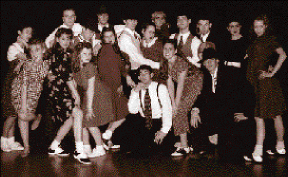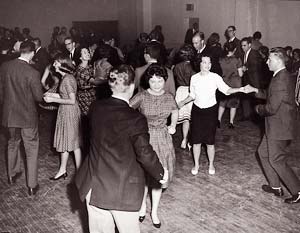By Kim Howey

Posed and ready to swing, members of BYU’s Swing Kids Club don the garb and dance the steps, first popular more than 50 years ago, of a trend that has America jumping.
In the 1930s and ’40s, BYU sponsored swing dances with feet tapping to bellowing horns and beating drums. Now–a half century later–BYU’s Swing Kids have picked up where their grandparents left off, with feet still flying and music still blaring and a tradition as strong as ever. With 700 members, Swing Kids is BYU’s largest club, a status it has maintained since its first full semester of existence in winter 1996.
“Swing never went completely out of style,” says Conan Heiselt, a senior from Lockeford, Calif., majoring in Chinese. “Like most styles, it circles around again every few decades. I’m sure that in five years or so, swing will again be on the way out for the mainstream, with only those in it for the music and life still hanging on.”
“Swing breaks down the social barriers that usually exist between guys and girls and allows them to be themselves,” says Aric Whitaker, the club’s vice president and a sophomore from Omak, Wash., majoring in computer science.
Elizabeth Lovelady, a senior from Lockeford,Calif., majoring in sociology, points out that the Savoy dance hall, where the earliest swing was performed, was the first interracial dance hall. “Jazz and big band swing brought people together in the 1930s and ’40s,” she says. For students at BYU, it continues this tradition.
In the mid-1990s, a few BYU students became hooked on swing through trends in their home cities but returned to Provo to find no venue for their newfound passion.
“I didn’t know anyone who did big band swing,” says Kacy Humberstone, a founder of Swing Kids and a senior from San Diego majoring in elementary education. When she decided to organize a swing group, she found that three independent groups were already meeting regularly in dorm lounges, wide hallways, or any empty space they could find.
“My group met in the garden court each week,” recalls Todd Lassig, a senior from Fountain Valley, Calif., majoring in broadcasting. “Someone would bring a boom box and others would bring swing CDs. It started from very humble beginnings.”
The groups eventually merged and by fall 1995 an official swing club was sanctioned by BYUSA and dubbed Swing Kids after the popular 1993 movie. The name stuck and so did its popularity.”The music commands us to dance,” says Melissa Lovelady Heiselt, a senior from Lockeford, Calif., majoring in English.
Within the first month, club membership quadrupled from 30 to 120, attracting members through word of mouth. Currently at 700 members, the club continues to grow. Lovelady compares the line at the weekly dance’s entrance (held in various locations around campus) to a line that stretched from First Street to Fifth Street reported in a 1935 New York Times article. When a reporter asked the swingers what everyone was there for, a swinger answered, “If you can’t feel it man, you’ll never know.” That quip has become a motto for many of the club’s members and even appears on club T-shirts.
“I have been astounded at the growth and interest in swing dancing over the last few years and amazed at the success of the club,” states Michael R. Kelly, Swing Kids advisor and professor of Russian. Many Swing Kids attribute the club’s success to the dance enculturation at the university. “We’ve grown up dancing; it’s a part of the Mormon culture,” says Mindy Perkins, a sophomore from Carlsbad, Calif., with an open major.
They insist, however, that swing varies significantly from other forms of dance. “Dancing is fun, but I didn’t get much out of the ‘deacon shuffle,'” Whitaker says. Swing incorporates a unique music with a unique dance, producing a merged rhythm. “There’s a lot of real energy in the horns and rhythm section of big band,” says Eric Orton, a junior from Houston, majoring in elementary education. “The footwork to the beat is what swing dance really is.”
Individual expression is paramount to swing, and variation dominates structure. “Swing is more do-your-own-thing.
It allows for the freedom of creativity. You learn the basics and how to lead and how to follow, but then you’re on your own,” says Julie Woodward, a freshman from Independence, Mo., with an open major.
Until recently, the club was unable to pay instructors to teach swing steps, but members feel that actually worked to their benefit. “The shortage of conforming instruction caused a wonderful phenomenon that is absent in other places: great individuality, intense style differences, growing skills in improvisation, and ability to create new steps and moves,” Heiselt says.
Even with a new weekly instruction program featuring steps like the Lindy Hop and the Triple Swing, members feel their swing styles still express their individuality. “Swing appeals to people because it has the leading, following, and dance etiquette of ballroom dancing, but a lot more energy than a waltz or a foxtrot,” Orton says. “When two dancers are in a groove with each other and doing a lot of original kicking moves and stop-time stuff, it looks amazing.”
As an official club the group is as complicated as its dance steps. “We keep ridiculously busy trying to keep everything in the air all at the same time,” says club president Matt Beck, a senior from Dallas, majoring in economics. “But somehow things have worked out.” Officers volunteer up to 20 hours a week, working on club business, such as organizing dances, providing weekly dance instruction, updating the Web site (https://skc.clubs.byu.edu), designing T-shirts and posters, coordinating advertising, sending instructors to family home evening groups, and compiling a video and written history.









